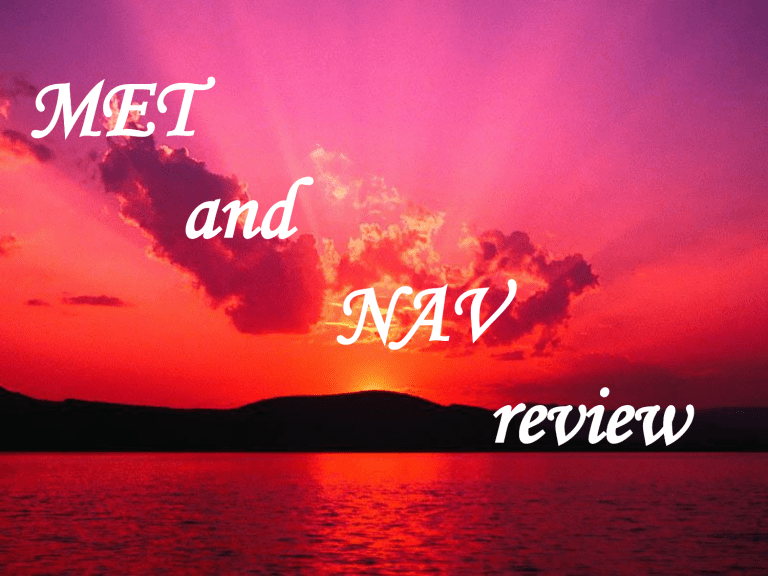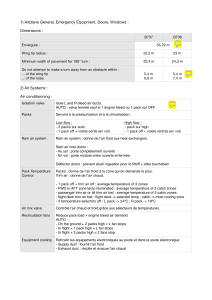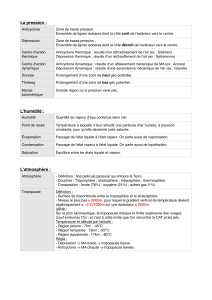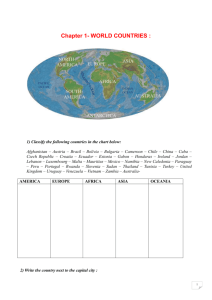26AER200apr27 met& NA+

MET and
NAV review
FINAL EXAM for sure study areas
PGF vs coriolis
Virga, subsidence, isotach, isotherm, isobar, VDF
Surface analysis vs prognostic chart
Temperature effect on altimeter
Stability - rising air and/or air masses
Frontal weather, GFA validity, wind limits
Light & variable, freezing level
Vacuum driven heading indicator for navigation
Rhumb line, great circle, small circle, agonic line, deviation vs. variation
Compass errors – northerly turning, ANDS, quadrantal
FINAL EXAM for sure study areas
Control zones, VFR minima, airspace classification, low level airspace, cruising altitudes, special VFR, transponder airspace
CDI, VOT check, VOR accuracy limits, ADF errors
VOR and ADF orientation and use, ADF tuning
One VFR cross country – planning log, flight plan,
Vnc chart completion, drift lines
Time zone adjustments, CFS use for planning, VHF frequencies, reserves, safety heights
ETA’s, Heading corrections, wind determination, revised ETA
Enroute GFA, TAF and METAR interpretation, PIREP interpretation, AIRMET interpretation
One in Sixty Rule
1 : 60 is the same as 1 degree
ANABATIC WIND
CLOUD CLASSIFICATION
TEMPERATURE
The atmosphere is heated from below.
Temperature increase decreases density.
Advection: horizontal movement of air. Cold air becomes warmed by the ground as it moves over it
Convection: sun heats ground, ground heats the air, warmer and less dense pockets rise
Turbulence: vertical movement of air due to winds and convection
Compression: air sinks, compresses and heats
(Chinooks, high pressure areas)
Advection: horizontal movement of air.
Cold air can be warmed by the ground as it moves over it
Air Masses of North America
Continental Arctic: Ca not in summer; low water content; warmed from below enroute, strong winds produce turbulence; heap clouds and snow showers; rarely in B.C. except as a cold-air invasion
(Continental Polar: Cp)
Maritime Arctic: Ma starts as Ca that spends some time over the northern Pacific ocean; moist and unstable at high altitudes; stratocumulus and cumulus; pe/sn/-shra; in summer: northern lakes affect the air mass
Maritime Polar: Mp more time spent over Pacific ocean; warmer in lower levels; more stable than Ma; orographic lifting makes rain west of mountains (Rockies) and dry air east of mountains;
Summer: Tsra/Cb
Maritime Tropical: Mt very warm and moist; Gulf of Mexico, Caribbean & south of 30
°N; Winter: rarely at the surface N of Great lakes, but present at high altitudes; unstable when subject to Frontal lift; gives sn/ra/zr/icing and turbulence; FOG (east coast); Summer: shra/tsra
Cumulus Stage:
Cloud driven upward by the latent heat as water vapour condenses
Strong updrafts prevail throughout .
Temperatures in cell are higher than outside temperature at the same level.
No precipitation while water and ice are suspended.
Mature Stage:
Heights may reach 60,000 feet
Updrafts up to 6,000 ft/min
As the water droplets grow large enough to fall, they drag air down with them.
Downdraft starts in the middle region of the cloud.
15-20 minutes in duration; lightning, microburst, hail, wind shear.
Appearance of precipitation on the ground .
Dissipation stage: downdraft spreads throughout the cell (except top) gradual cessation of rainfall and the passing rain cools the lower regions
Anvil shape
WEATHER TERMINOLOGY
SKY CONDITION
Clear:
Few:
0/8
1/8 to 2/8
Scattered: 3/8 to 4/8
Broken: 5/8 to 7/8
Overcast: 8/8
IFR: less than 1000 ft
MVFR: 1000-3000 ft
&/or
3 miles
&/or
3-5 miles
VFR: greater than 3000 ft
& better than 5
ACTUAL LAPSE RATE
METAR CYKZ 251100Z 01009KT 7SM BKN040 BKN240 M08/M13
A2977 RMK SC4CI2 SLP095
FCST BASED ON 251200 DATA VALID 251800 FOR USE 17-21
3000 6000 9000 12000
YYZ 0410 0506-13
6000 -13
650 -08
Lapse may be roughly 1 o /1,000 ft
9900-13 1909-17
4000 cloud base -13
650
Lapse roughly 1.5
o
-08
/1,000 ft
Note that the lowest layer of cloud is SC (cumulus) and likely formed from convection.
Consider that any rising pockets had a dew point of -13 and therefore reached dew point and formed cloud at 4,000, before they got to the 6,000 foot altitude where temperature is actually measured
GFA
Issued at 2330Z, 0530Z, 1130Z and 1730Z
Covers 12 hours with a 12 hour IFR outlook
Country covered with 7 GFA areas
Heights are feet above sea level
Section 3 of MET in AIP
Minimum of 5k to have speed be indicated
CU, TCU, CB and ACC will be indicated
Winds less than 20 k usually not shown
Amended GFA shows CCA, etc. in title box
5-8 Geostrophic Wind
5-11 Surface Friction
FOG
FOG
Fog is cloud (usually stratus) that is in contact with the ground.
forms in relatively stable air where the temperature to dew point spread is small, wind may be present requires condensation nuclei
Usually needs a cooling process
Types of Fog:
Radiation
Upslope
Frontal
Advection
Steam
Ice
Radiation Fog: clear night, light wind, high humidity, often a high pressure area.
Advection Fog: warm moist air moving over colder land, horizontal movement, warm fronts/oceans, sometimes strong winds (+25kts)
Upslope Fog
Ice Fog: Byproduct of fuel burn in engine is water (as vapour)… added to cold crisp air.
(sublimation: vapour to ice)
Frontal Fog: vapour addition raises the dew point of the air mass under a warm front
Steam fog: cold air moving over a warm surface
FLIGHT
PLAN see RAC section in
AIM
CANADIAN FLIGHT PLAN AND FLIGHT ITINERARY
PLAN DE VOL ET ITINÉRAIRE DE VOL CANADIEN
PRIORITY / PRIORITÉ ADDRESSEE(S) / DESTINATAIRE(S)
FF
ICAO FLIGHT PLAN
PLAN DE VOL OACI
FILING TIME / HEURE DE DÉPÔT
ORIGINATOR / EXPÉDITEUR
SPECIFIC IDENTIFICATION OF ADDRESSEE(S) AND/OR ORIGINATOR / IDENTIFICATION PRÉCISE DU(DES) DESTINATAIRE(S) ET/OU DE L’EXPÉDITEUR
3 MESSAGE TYPE
TYPE DE MESSAGE
(FPL
9 NUMBER / NOMBRE
7 AIRCRAFT IDENTIFICATION /
IDENTIFICATION DE L’AÉRONEF
TYPE OF AIRCRAFT / TYPE D’AÉRONEF
/
8 FLIGHT RULES /
RÈGLES DE VOL
WAKE TURBULENCE CAT. /
CAT. DE TURBULENCE DE SILLAGE
TYPE OF FLIGHT /
TYPE DE VOL
10 EQUIPMENT / ÉQUIPEMENT
13 DEPARTURE AERODROME / AÉRODROME DE DÉPART
TIME / HEURE
15 CRUISING SPEED /
VITESSE DE CROISIÈRE ALTITUDE / LEVEL / NIVEAU ROUTE / ROUTE
16 DESTINATION AERODROME
AÉRODROME DE DESTINATION
TOTAL EET / DURÉE TOTALE ESTIMÉE
DAYS/JOURS HRS MINS
18 OTHER INFORMATION / RENSEIGNEMENTS DIVERS
19 ENDURANCE / AUTONOMIE
SAR
HRS MINS
ALTN AERODROME /
AÉRODROME DE DÉGAGEMENT
2ND ALTN AERODROME /
2e AÉRODROME DE DÉGAGEMENT
)
EMERGENCY RADIO / RADIO DE SECOURS
E /
HRS MINS PERSONS ON BOARD / PERSONNES À BORD
P /
UHF
R / U
VHF
V
ELT
A /
SURVIVAL EQUIPMENT / ÉQUIPEMENT DE SURVIE
POLAR DESERT MARITIME
POLAIRE DÉSERT MARITIME
S / P D M
JUNGLE
JUNGLE
J
JACKETS / GILETS DE SAUVETAGE
LIGHT FLUORES
LAMPES FLUORES
J / L F
DINGHIES / CANOTS
NUMBER
NOMBRE
CAPACITY
CAPACITÉ
COVER
COUVERTURE
COLOUR
COULEUR
D /
C
AIRCRAFT COLOUR AND MARKINGS / COULEUR ET MARQUES DE L’AÉRONEF
WHEELS
ROUES
E
UHF
U
ELT TYPE / TYPE D’ELT
VHF
V
SEAPLANE
HYDRAVION SKIS
AMPHIBIAN
AMPHIBIE
REMARKS / REMARQUES
N /
AN ARRIVAL REPORT WILL BE FILED WITH / UN COMPTE RENDU D’ARRIVÉE SERA NOTIFIÉ À :
NAME AND PHONE NUMBER OR ADDRESS OF PERSONS(S) OR COMPANY TO BE NOTIFIED IF SEARCH AND RESCUE ACTION INITIATED /
NOM ET NUMÉRO DE TÉLÉPHONE OU ADRESSE DE LA (DES) PERSONNE(S) OU COMPAGNIE À AVISER SI DES RECHERCHES SONT ENTREPRISES
PILOT-IN-COMMAND / PILOTE COMMANDANT DE BORD
C /
FILED BY / DÉPOSÉ PAR
PILOT’S LICENCE NO. / N° DE LICENCE DU PILOTE
)
SPACE RESERVED FOR ADDITIONAL REQUIREMENTS / ESPACE RÉSERVÉ À DES FINS SUPPLÉMENTAIRES
NC26-0516 (2001-05)
CANADIAN FLIGHT PLAN AND FLIGHT ITINERARY
PLAN DE VOL ET ITINÉRAIRE DE VOL CANADIEN
PRIORITY / PRIORITÉ ADDRESSEE(S) / DESTINATAIRE(S)
FF
ICAO FLIGHT PLAN
PLAN DE VOL OACI
FILING TIME / HEURE DE DÉPÔT
ORIGINATOR / EXPÉDITEUR
SPECIFIC IDENTIFICATION OF ADDRESSEE(S) AND/OR ORIGINATOR / IDENTIFICATION PRÉCISE DU(DES) DESTINATAIRE(S) ET/OU DE L’EXPÉDITEUR
3 MESSAGE TYPE
TYPE DE MESSAGE
(FPL
9 NUMBER / NOMBRE
7 AIRCRAFT IDENTIFICATION /
IDENTIFICATION DE L’AÉRONEF
TYPE OF AIRCRAFT / TYPE D’AÉRONEF
8 FLIGHT RULES / TYPE OF FLIGHT /
RÈGLES DE VOL TYPE DE VOL
WAKE TURBULENCE CAT. /
CAT. DE TURBULENCE DE SILLAGE
/
10
EQUIPMENT / ÉQUIPEMENT
13 DEPARTURE AERODROME / AÉRODROME DE DÉPART
TIME / HEURE
15 CRUISING SPEED /
VITESSE DE CROISIÈRE ALTITUDE / LEVEL / NIVEAU ROUTE / ROUTE
16 DESTINATION AERODROME
AÉRODROME DE DESTINATION
TOTAL EET / DURÉE TOTALE ESTIMÉE
DAYS/JOURS HRS MINS
18 OTHER INFORMATION / RENSEIGNEMENTS DIVERS
SAR ALTN AERODROME / 2ND ALTN AERODROME /
HRS MINS AÉRODROME DE DÉGAGEMENT 2e AÉRODROME DE DÉGAGEMENT
)
ENDURANCE / AUTONOMIE EMERGENCY RADIO / RADIO DE SECOURS 19
E /
HRS MINS PERSONS ON BOARD / PERSONNES À BORD
P /
UHF
R / U
SURVIVAL EQUIPMENT / ÉQUIPEMENT DE SURVIE
POLAR
POLAIRE
DESERT
DÉSERT
MARITIME
MARITIME
S / P D M
VHF
V
ELT
JUNGLE
JUNGLE
J
JACKETS / GILETS DE SAUVETAGE
LIGHT
LAMPES
J / L
FLUORES
FLUORES
F
E
UHF
U
DINGHIES / CANOTS
NUMBER
NOMBRE
CAPACITY
CAPACITÉ
D /
COVER
COUVERTURE
C
COLOUR
COULEUR
AIRCRAFT COLOUR AND MARKINGS / COULEUR ET MARQUES DE L’AÉRONEF
A /
REMARKS / REMARQUES
N /
AN ARRIVAL REPORT WILL BE FILED WITH / UN COMPTE RENDU D’ARRIVÉE SERA NOTIFIÉ À :
WHEELS
ROUES
ELT TYPE / TYPE D’ELT
VHF
V
SEAPLANE
HYDRAVION SKIS
AMPHIBIAN
AMPHIBIE
NAME AND PHONE NUMBER OR ADDRESS OF PERSONS(S) OR COMPANY TO BE NOTIFIED IF SEARCH AND RESCUE ACTION INITIATED /
NOM ET NUMÉRO DE TÉLÉPHONE OU ADRESSE DE LA (DES) PERSONNE(S) OU COMPAGNIE À AVISER SI DES RECHERCHES SONT ENTREPRISES
PILOT-IN-COMMAND / PILOTE COMMANDANT DE BORD
C /
FILED BY / DÉPOSÉ PAR
PILOT’S LICENCE NO. / N° DE LICENCE DU PILOTE
)
SPACE RESERVED FOR ADDITIONAL REQUIREMENTS / ESPACE RÉSERVÉ À DES FINS SUPPLÉMENTAIRES
NC26-0516 (2001-05)
CANADIAN FLIGHT PLAN AND FLIGHT ITINERARY
PLAN DE VOL ET ITINÉRAIRE DE VOL CANADIEN
PRIORITY / PRIORITÉ ADDRESSEE(S) / DESTINATAIRE(S)
FF
ICAO FLIGHT PLAN
PLAN DE VOL OACI
FILING TIME / HEURE DE DÉPÔT
ORIGINATOR / EXPÉDITEUR
SPECIFIC IDENTIFICATION OF ADDRESSEE(S) AND/OR ORIGINATOR / IDENTIFICATION PRÉCISE DU(DES) DESTINATAIRE(S) ET/OU DE L’EXPÉDITEUR
3 MESSAGE TYPE
TYPE DE MESSAGE
(FPL
9 NUMBER / NOMBRE
7 AIRCRAFT IDENTIFICATION /
IDENTIFICATION DE L’AÉRONEF
TYPE OF AIRCRAFT / TYPE D’AÉRONEF
8 FLIGHT RULES / TYPE OF FLIGHT /
RÈGLES DE VOL TYPE DE VOL
WAKE TURBULENCE CAT. /
CAT. DE TURBULENCE DE SILLAGE
/
10
EQUIPMENT / ÉQUIPEMENT
13 DEPARTURE AERODROME / AÉRODROME DE DÉPART
TIME / HEURE
15 CRUISING SPEED /
VITESSE DE CROISIÈRE ALTITUDE / LEVEL / NIVEAU ROUTE / ROUTE
16 DESTINATION AERODROME
AÉRODROME DE DESTINATION
TOTAL EET / DURÉE TOTALE ESTIMÉE
DAYS/JOURS HRS MINS
18 OTHER INFORMATION / RENSEIGNEMENTS DIVERS
SAR ALTN AERODROME / 2ND ALTN AERODROME /
HRS MINS AÉRODROME DE DÉGAGEMENT 2e AÉRODROME DE DÉGAGEMENT
)
ENDURANCE / AUTONOMIE EMERGENCY RADIO / RADIO DE SECOURS
REMARKS / REMARQUES
N /
AN ARRIVAL REPORT WILL BE FILED WITH / UN COMPTE RENDU D’ARRIVÉE SERA NOTIFIÉ À :
19
E /
HRS MINS PERSONS ON BOARD / PERSONNES À BORD
P /
UHF
R / U
SURVIVAL EQUIPMENT / ÉQUIPEMENT DE SURVIE
POLAR
POLAIRE
DESERT
DÉSERT
MARITIME
MARITIME
S / P D M
VHF
V
ELT
JUNGLE
JUNGLE
J
JACKETS / GILETS DE SAUVETAGE
LIGHT
LAMPES
J / L
FLUORES
FLUORES
F
E
UHF
U
DINGHIES / CANOTS
NUMBER
NOMBRE
CAPACITY
CAPACITÉ
D /
COVER
COUVERTURE
C
COLOUR
COULEUR
AIRCRAFT COLOUR AND MARKINGS / COULEUR ET MARQUES DE L’AÉRONEF
A /
WHEELS
ROUES
ELT TYPE / TYPE D’ELT
VHF
V
SEAPLANE
HYDRAVION SKIS
AMPHIBIAN
AMPHIBIE
NAME AND PHONE NUMBER OR ADDRESS OF PERSONS(S) OR COMPANY TO BE NOTIFIED IF SEARCH AND RESCUE ACTION INITIATED /
NOM ET NUMÉRO DE TÉLÉPHONE OU ADRESSE DE LA (DES) PERSONNE(S) OU COMPAGNIE À AVISER SI DES RECHERCHES SONT ENTREPRISES
PILOT-IN-COMMAND / PILOTE COMMANDANT DE BORD
C /
FILED BY / DÉPOSÉ PAR
PILOT’S LICENCE NO. / N° DE LICENCE DU PILOTE
)
SPACE RESERVED FOR ADDITIONAL REQUIREMENTS / ESPACE RÉSERVÉ À DES FINS SUPPLÉMENTAIRES
NC26-0516 (2001-05)
CYOO
GOLF ME 11 FEB
Hwy 7 67 71 NW 04/10 11w 9 :07 0.8
1.1
Hwy Barrie 45 91 91 311 045/8 316 11w 327 91 39 :26 1.9
Nota Bay
CNY3
45 91 91 291 045/5 294 10w 304 92 17 :11 0.8
85 SW 06/06 10w 6 :06 0.5
FLIGHT PLANNING
LOG
71 :50 5.1
:30 2.2
71 1:20 7.3
WAC
LOW LEVEL AIRWAYS
From 2,200’ AGL up to but not including 18,000’ ASL
IFR & VFR SUMMARY
KZ 2
Track = 189º
Ground Speed = 122 kt
Heading = 196º
TAS = 106 kt
Practice
Problem D
Wind Direction = 332º
Wind speed = 20 kt
106 kt
122 kt
106 kt
Xwind
& CRFI
PQ 1
Obstacles, Arcal,
ATF & Peripheral frequency
FDs – Interpolation
FCST BASED ON 251200 DATA VALID 251800 FOR USE 17-21
3000 6000 9000 12000 18000
YAM 0117 3613-19
YOW 0720 0814-13
YQG 3309 3109-14
YVV 0606 0305-15
YYB 1825 2034-16
YYZ 0410 0506-13
9900-21
1109-12
2707-16
9900-17
2055-17
9900-13
9900-26
1614-15
2313-20
2016-20
2073-20
1909-17
2408-35
1934-22
2232-28
2039-28
7013-28
1927-25
CYGK
GULP ME 22 MAR 01
CYGK
Start, t/o
CYOW
Contingency
Include if appropriate circuit
55
67 NE 13w :10 1.5
0.8
92 97 031 220/18 029 13w 042 114 76 :40 3.1
20% fuel 1.9
:06 0.5
FLIGHT PLANNING
LOG
76 :56 7.8
:30 2.2
76 1:26 10.0
VOR
VOR
EQUIPMENT
CHECKS
TRACKING AWAY FROM A STATION
TRACKING TO A STATION
ADF
LIMITATIONS
TWILIGHT EFFECT
• JUST BEFORE/AFTER SUNSET/SUNRISE - fly high
• GREATER AT GREAT DISTANCE – use less than 350 khz
TERRAIN or MOUNTAIN EFFECT
SHORELINE – signals crossing at less than 30 o
ELECTRICAL STORMS
BANK ERROR – ALL TURNS
• LOOP ANTENNAE ROTATES TO SENSE DIRECTION OF
INCOMING SIGNAL AND IS MOUNTED PARALLEL TO
NORMAL AXIS
SOME RULES
1.
WHEN INTERCEPTING A TRACK TO OR FROM A
STATION, BEARING INDICATOR ALWAYS AWAY
FROM 0 OR TOWARDS 180
2.
WHEN TURNING, IF HEADING INDICATOR INCREASES,
THEN ADF BEARING INDICATOR (VALUE) DECREASES
HI LESS, ADF MORE
3.
WHEN TRACKING, NEEDLE RIGHT? YES, THEN WIND IS
FROM THE RIGHT SO TURN RIGHT, ETC.
4.
MAGNETIC HEADING + RELATIVE BEARING = MAGNETIC
BEARING TO THE STATION
MH + RB = MB TO THE STATION
MH = MB – RB
RB = MB - MH


